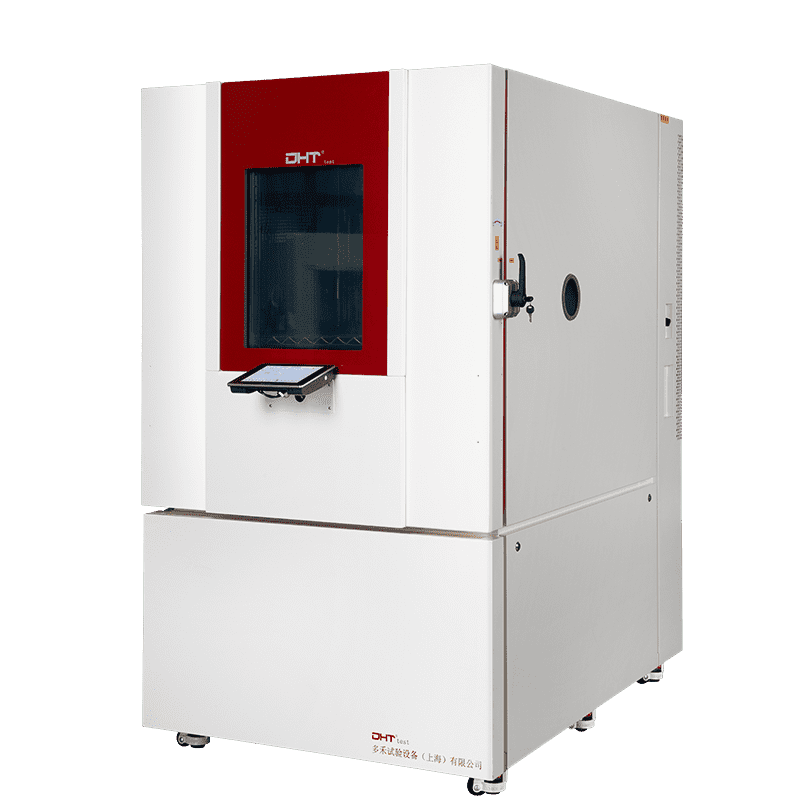Geschrieben von Robin
Leitender Ingenieur, Doaho Test (DHT®)
Da sich Fahrzeuge mit neuer Energie (NEV) weiterhin rasant entwickeln, ist die Umweltresistenz ihrer drei Kernelemente - Batterie, Motor und elektronische Steuerung - zu einem entscheidenden Faktor für die Bewertung der Zuverlässigkeit und Sicherheit des gesamten Fahrzeugs geworden. Insbesondere bei extremen Klimabedingungen, dünner Luft in großen Höhen oder herausfordernden Straßenverhältnissen beeinflusst die Fähigkeit dieser Systeme, einen stabilen Betrieb aufrechtzuerhalten, direkt die Wettbewerbsfähigkeit auf dem Markt. Begehbare Testkammern spielen eine Schlüsselrolle bei der Durchführung präziser Temperaturzyklen für groß angelegte Systeme und bieten sowohl für gesamte Fahrzeuge als auch für Bauteile realistische und kontrollierte Umweltsimulationen.
1. Warum ist das Hoch- und Niedertemperatur-Testen für NEVs unerlässlich?
NEVs operieren in einem weiten Temperaturspektrum - von frostigen Morgen bei -40°C bis hin zu heizenden Innenraumtemperaturen über 60°C. Häufige Start-Stopp-Zyklen, schnelles Laden und schnelle Beschleunigung setzen Fahrzeugssysteme großen thermischen Belastungen aus, die insbesondere betreffen:
-
Bewertung der Batterieleistung: Kapazitätsabnahme und erhöhte Innenwiderstände bei niedrigen Temperaturen sowie Risiken der thermischen Überhitzung bei hohen Temperaturen;
-
Überprüfung der thermischen Stabilität des Antriebssystems: Motoren und Steuerungen müssen innerhalb sicherer Temperaturbereiche arbeiten, um eine konstante Leistung und lange Lebensdauer zu gewährleisten;
-
Effektivität des Thermomanagementsystems: Bewertung der Kühlleistung und Reaktionsfähigkeit bei raschen Temperaturschwankungen;
-
Testen der thermischen Kompatibilität kritischer Materialien: Sicherstellung, dass die Ausdehnungskoeffizienten von Dichtungen, Kabelbäumen und Innenraumpartien gut aufeinander abgestimmt sind.
Angesichts dieser Herausforderungen ist eine begehbare Kammer, die diese Umweltvariablen präzise regulieren kann, unerlässlich, um die Fahrzeugqualität und -sicherheit zu gewährleisten.
2. Kerntechnische Vorteile von begehbaren Testkammern
Im Vergleich zu traditionellen kleineren Umweltkammern bieten begehbare Testkammern ein größeres Volumen, Integration und Skalierbarkeit - Eigenschaften, die perfekt für die Entwicklungs- und Validierungsanforderungen von Fahrzeugen mit neuer Energie passen:
-
Unterstützung für Full-Vehicle- oder Großsubsystemtests: Das begehbare Design fasst große Batteriemodule, Antriebssysteme und sogar teilweise Fahrzeugstrukturen und erfüllt Platz- und Funktionsanforderungen für System-Temperaturzyklustests.
-
Breites Temperaturspektrum mit schneller Temperaturwechselmöglichkeit: Fortschrittliche Modelle decken Bereiche von -70°C bis +150°C ab, mit Temperaturwechselraten zwischen 3°C und 10°C pro Minute, und erfüllen Standards wie IEC 60068-2-14 und GB/T 31467.3.
-
Simulation von multifaktoriellen Umwelten: Modulare Integration von Feuchtigkeitskontrolle (10%-98% RH), niedrigem Druck, Bedingungen in großer Höhe, Kondensationsspray und Sonneneinstrahlungssimulation ermöglicht komplexe Testumgebungen, die realen Bedingungen nahe kommen.
-
Intelligente Testabläufe und Datenerfassung: Ausgestattet mit Fernsteuerung, automatischer Datenprotokollierung, Warnungen bei Anomalien und Konnektivität zu MES-Systemen, optimieren diese Kammern Testprozesse und ermöglichen umfassende Rückverfolgbarkeit.
3. Beispiel aus der Praxis
Ein führender NEV-Hersteller nutzte eine begehbare Kammer, um einen kontinuierlichen Temperaturzyklus zwischen -40°C und +120°C für ein 800-V-Hochspannungs-Antriebssystem über 72 Stunden durchzuführen. Durch strategische Platzierung von Thermoelementen an den IGBT-Modulen, Motorwicklungen und Steuerplatinen sammelten die Ingenieure präzise Temperaturdaten, die eine Neugestaltung des Kühlsystems leiteten und die IGBT-Temperaturen um 12% reduzierten, wodurch die Zuverlässigkeit des Gesamtsystems wesentlich verbessert wurde.
4. Auswahlhinweise und wichtige Überlegungen
Bei der Auswahl einer begehbaren Testkammer für NEV-Tests sollten Sie diese Schlüsselfaktoren priorisieren:
-
Temperaturgleichmäßigkeit: Stellen Sie sicher, dass die Temperaturdifferenzen an den Teststellen innerhalb von ±2°C bleiben;
-
Belastungskapazität und Probenmontage: Die Testplattform sollte die physische Anordnung von Batteriemodulen oder Antriebssystemen aufnehmen können;
-
Robuste Sicherheitsmerkmale: Integrieren Sie Übertemperaturalarm, Druckschutz für Kältemittel und Schutz vor elektrischer Überlastung, um sichere Testoperationen zu gewährleisten;
-
After-Sales-Service und Anpassung: Wählen Sie Lieferanten mit nachgewiesener Erfahrung in der NEV-Industrie, die maßgeschneiderte Lösungen und hervorragende langfristige Unterstützung bieten.
Fazit: Von simulierten Umgebungen zu verifizierter Qualität
Da sich die NEV-Technologie hin zu höherer Leistung, größerer Integration und intelligenterer Steuerung entwickelt, haben sich begehbare Testkammern von einfachen Umweltsimulatoren zu fundamentalen Werkzeugen entwickelt, die Markenverlässlichkeit und technisches Vertrauen aufbauen. Sie unterziehen Produkte im Labor den schlimmsten Szenarien, damit sie in der realen Welt optimal funktionieren.
Wenn Sie maßgeschneiderte Lösungen für begehbare Testkammern für Ihre NEV-Entwicklungsanforderungen erkunden möchten, wenden Sie sich bitte an DHT®. Unser Expertenteam steht bereit, um Ihnen maßgeschneiderte technische Unterstützung zu bieten und Ihnen zu helfen, jede Umweltherausforderung souverän zu meistern. Entdecken Sie, wie DHT® begehbare Testkammern extreme Klimabedingungen simulieren, um die Batterieleistung, die Komponenten und die Fahrzeugleistung von NEVs für die weltweite Markttauglichkeit zu validieren.Wie begehbare Kammern die Klimaresistenz von NEVs verbessern | DHT®
Häufig gestellte Fragen
Warum sind Hoch- und Niedertemperaturtests für neue Elektrofahrzeuge (NEVs) wichtig?
NEVs arbeiten in einer Vielzahl von Umgebungen, von -40°C bis über 60°C. Extreme Temperaturen beeinflussen die Batteriekapazität, die Stabilität des Antriebssystems und die Leistung des Wärmemanagements. Hoch- und Tieftemperaturtests stellen sicher, dass Batterien, Motoren, Steuerungen und Materialien unter diesen realen Bedingungen Sicherheit und Leistung aufrechterhalten.
Welche Vorteile bieten Begehbare Prüfkabinen für die NEV-Prüfung?
Begehbare Testkammern bieten größere Testvolumina, die vollständige Fahrzeug- oder Subsystemtests ermöglichen. Sie bieten breite Temperaturbereiche (-70°C bis +150°C), schnelle Rampenraten und Unterstützung für multifaktorielle Simulationen wie Feuchtigkeit, Höhe und Sonnenstrahlung. Diese Fähigkeiten machen sie ideal für umfassende Zuverlässigkeitsvalidierungen von NEVs.
Was sollte bei der Auswahl einer Begehbaren Prüfzelle für NEVs berücksichtigt werden?
Zu den Schlüsselfaktoren gehören die Temperaturgleichmäßigkeit (innerhalb von ±2°C), die Belastungskapazität, die Sicherheitssysteme und die Kompatibilität mit NEV-spezifischen Einrichtungen. Ebenfalls wichtig sind fortschrittliche Steuerungsfunktionen wie Fernüberwachung, Datenprotokollierung und Integration in MES-Systeme. Wählen Sie Anbieter mit nachgewiesener Erfahrung in der Branche der neuen Energiefahrzeuge für zuverlässige Anpassung und Unterstützung.


